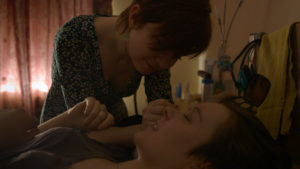by Peggy Munson
 Watching Jen Brea’s film Unrest, I couldn’t stop thinking about Heather and the other friends I have lost to suicide over the handful of years Brea spent making this film. Heather Askeland (Johnson)* was the third of four in recent years: sick friends of mine who chose suicide after immense physical suffering, all with ME/CFS, Lyme, MCS, or a combination of these illnesses that formed a mimetic minefield of debilitating symptoms, what Julie Genser of PlanetThrive.com calls “clusterfuck illnesses.” Heather’s ironic “It Gets Better” video on YouTube circles around the line, “Just be kind.” Her number is still in my phone, along with an embarrassing notation “deceased.” Some part of me thinks if I call the number, I’ll hear her voice on voicemail saying something sweet and funny and kind, the way we used to go back and forth since I’m too sick to talk out loud or “live” most of the time. As I watch Jen’s partner Omar say to Jen, “If I can talk to you, if I can hold you tight, I’m good,” I’m picking apart the particulars (as if they need my meddling!): would he stay if she couldn’t ever talk or could rarely talk like me, if he had to quit his academic job to care for her?
Watching Jen Brea’s film Unrest, I couldn’t stop thinking about Heather and the other friends I have lost to suicide over the handful of years Brea spent making this film. Heather Askeland (Johnson)* was the third of four in recent years: sick friends of mine who chose suicide after immense physical suffering, all with ME/CFS, Lyme, MCS, or a combination of these illnesses that formed a mimetic minefield of debilitating symptoms, what Julie Genser of PlanetThrive.com calls “clusterfuck illnesses.” Heather’s ironic “It Gets Better” video on YouTube circles around the line, “Just be kind.” Her number is still in my phone, along with an embarrassing notation “deceased.” Some part of me thinks if I call the number, I’ll hear her voice on voicemail saying something sweet and funny and kind, the way we used to go back and forth since I’m too sick to talk out loud or “live” most of the time. As I watch Jen’s partner Omar say to Jen, “If I can talk to you, if I can hold you tight, I’m good,” I’m picking apart the particulars (as if they need my meddling!): would he stay if she couldn’t ever talk or could rarely talk like me, if he had to quit his academic job to care for her?
But I want Omar to be this kind: we all desperately need that. I’ve faced this challenge before of how to view the art of someone with admitted cognitive problems whose speech (like mine) can turn to stroke-like gibberish, at times seeking global reach from her bed. Still, the unkindness of nearly 26 years of illness feels engulfing to me, and I’m aware of the pursuant black hole of ME/CFS history. This history has spanned over half of my life. If she is appointing herself as a spokesperson, the activists and artists who came before her need a critical voice.
So, watching the film of the person who invented the “Millions Missing” hashtag, because of this heroic partner-caregiver trope the media calls a “love story” (as they often did with previously most-visible ME/CFS patient, bestselling Seabiscuit author Laura Hillenbrand, and her boyfriend-then-husband Borden), I’m painfully noticing what is missing from Brea’s narrative – the patients without caregivers, heterosexual privilege, families who believe them. The black transwoman with ME/CFS I used to email with who suddenly just vanished from my screen and doesn’t fit into the film’s binary-sounding (too 2nd wave) feminism, my friend who emigrated to the US as a child before getting sick to grow up in a largely-Latino neighborhood shoved out by gentrification and toxins and inability to move away from repeated natural disasters she can’t escape. My friends who can’t find any aides to hire (especially fragrance free) or who post online about their life-threateningly—incompetent aides, the gross statistical reality that 80-90 percent of care in the US for disabled adults is provided by families (so what if they say no, as mine callously did?). My own flashbacks happen almost every night now of how my own family left me for dead without survival care and I nearly died from ME/CFS and secondary tick-borne illness complications, lying next to a toilet all day every day for over 7 months because it was as far as I could drag myself from bed, ultimately waiting to die while gasping for breath in respiratory failure (from secondary Babesia duncani that ravaged my body the way it would in an AIDS patient), and I’ve spent nine years now trying to recover because myalgic encephalomyelitis’ signature symptom is post-exertional malaise (PEM) that can last for years, not just days, and I likely won’t recover, while Brea hops over to my native Midwest where I haven’t been able to travel and get home in nearly 20 years. It’s not all really a love story. It’s not that kind. It’s trench fighting, and trauma. It’s not wrong how we’ve had to survive.
 So, I’m also thinking about the Harvard-and-Princeton story in Brea’s film, and those who didn’t have their wedding announcement in the New York Times as Brea did reflecting what one review called her prior “storybook life”; and the recent comments by NY doctor Susan Levine to the 2017 Discovery Forum about the inequities in ME’s paltry allotted funding favoring Northeast elitism, “”Dr. Levine offered additional remarks that praised the creation of the NIH CRC’s, but criticized that the awards are concentrated in metropolitan areas on the eastern seaboard. Speaking from her experience as a clinician, Dr. Levine pondered ‘where’s the access for the people with ME/CFS who live in the rural Midwest? I’ve been practicing in the same place for thirty years and I still don’t have a good primary care physician or neurologist to refer patients to.’” Then, I’m recoiling from a blog by someone named Brooke that Brea flew out to interview in the Midwest – and Brooke came away with the distinct impression Brea wanted to appropriate the story of someone dying in hospice from severe ME, while weirdly using the Asian face of her husband but none of his quotes for more visible “diversity.” Brooke notably opposes the film, writing horrifyingly, “She also believed (as did my entire medical team) that I would die before filming was completed. I believe she lied to me to get me to agree to be in her film so she could use my death to give added power to her narrative.”.
So, I’m also thinking about the Harvard-and-Princeton story in Brea’s film, and those who didn’t have their wedding announcement in the New York Times as Brea did reflecting what one review called her prior “storybook life”; and the recent comments by NY doctor Susan Levine to the 2017 Discovery Forum about the inequities in ME’s paltry allotted funding favoring Northeast elitism, “”Dr. Levine offered additional remarks that praised the creation of the NIH CRC’s, but criticized that the awards are concentrated in metropolitan areas on the eastern seaboard. Speaking from her experience as a clinician, Dr. Levine pondered ‘where’s the access for the people with ME/CFS who live in the rural Midwest? I’ve been practicing in the same place for thirty years and I still don’t have a good primary care physician or neurologist to refer patients to.’” Then, I’m recoiling from a blog by someone named Brooke that Brea flew out to interview in the Midwest – and Brooke came away with the distinct impression Brea wanted to appropriate the story of someone dying in hospice from severe ME, while weirdly using the Asian face of her husband but none of his quotes for more visible “diversity.” Brooke notably opposes the film, writing horrifyingly, “She also believed (as did my entire medical team) that I would die before filming was completed. I believe she lied to me to get me to agree to be in her film so she could use my death to give added power to her narrative.”.
I can’t assume Brea had any negative intentions, but I found Brooke’s blog very disturbing. Narrative can be a granted power, or can usurp power, and I wish it didn’t have to be about who gets the talking stick handed to them; but in this hard-scrabble life of illness, it does. Jen and Omar have surely endured other forms of hardship or oppression the film barely grazes with the favored narrative of a lost storybook life, and they are likeable personalities. Ultimately, though, there is no meritocracy in art or in these illnesses. And 26 years deep into severe ME/CFS, this is my critical lens; that I’m so missing now that my Midwestern family ghosts me and pretends I’m already dead and has been doing so for most of nine years because I also nearly died from this. Who does get to tell the stories of ghosts? Right now, Brea does.
Jen Brea’s Unrest nobly began as a vision of bringing unseen patients together and out into the streets, addressing these critical questions of invisibility, even displaying someone as a pair of empty shoes or a photograph at her Millions Missing protests. It’s utopian, maybe at times naive after decades of activist struggle around ME/CFS. She did go into this grand ambition with an eye toward a corrupt history of government malfeasance, derogatory language that has shamed and blamed patients, people stepping on people who spend most of their time flat – and wanted to give patients one thing they’d been denied: a visual language to convey the devastation and defend against abusive psychiatric projections, a narrative that knitted patients’ remote, darkened rooms together. All of that is admirable and much-needed, and it’s impressive she did pull off some of this impossibly sweeping goal from bed. It’s also notable she’s not the first, and her film does borrow from thematic threads of earlier art and media around ME/CFS. There have been other films on ME/CFS from filmmakers who didn’t hit this same wormhole in time of crowd-funding and momentary media interest, such as I Remember Me by Kim Snyder (free with Amazon Prime), Forgotten Plague (free with Amazon Prime), and the especially accomplished Voices from the Shadows (also free online via the website).
 Unrest has positive moments as well as missteps. It succeeds most where it’s most stripped down and shedding its polemic and an imposed, too-cursory narrative: where the faces of doctors Nancy Klimas and Paul Cheney and researcher Ron Davis (whose son Whitney, also shown, has severe ME/CFS and is bedbound and can’t speak and is devastating to watch) show old battle wounds, where Jen is falling to the floor in a moment those with dysautonomia from ME know well, where Omar strategizes painfully about how to not sound too knowledgeable in an emergency room so she won’t be treated as hysterical (people once gave me that same advice; two patients I know were diagnosed with somatoform diagnoses after going into ERs with ME/CFS), where the whiteboard reveals her addled brain making brilliant etchings and the lines turn into more diversionary lines as Jen gets caught in that snarl and frustration and ends up trapped here in ME, no end in sight; it’s obliterating, relatable, and real. Anyone watching this wishes they’d “left the camera running” too, to capture those moments no one sees, in that terrifying tumble from sudden fever to the doctor telling her the prognosis five years in will be grim; and finally, people’s lives so stilled they’re snapshots, no longer moving pictures, reduced to a dark room and a bed. Will it be like this forever, the audience wonders? No one knows. ME is not a disease, it’s total damnation.
Unrest has positive moments as well as missteps. It succeeds most where it’s most stripped down and shedding its polemic and an imposed, too-cursory narrative: where the faces of doctors Nancy Klimas and Paul Cheney and researcher Ron Davis (whose son Whitney, also shown, has severe ME/CFS and is bedbound and can’t speak and is devastating to watch) show old battle wounds, where Jen is falling to the floor in a moment those with dysautonomia from ME know well, where Omar strategizes painfully about how to not sound too knowledgeable in an emergency room so she won’t be treated as hysterical (people once gave me that same advice; two patients I know were diagnosed with somatoform diagnoses after going into ERs with ME/CFS), where the whiteboard reveals her addled brain making brilliant etchings and the lines turn into more diversionary lines as Jen gets caught in that snarl and frustration and ends up trapped here in ME, no end in sight; it’s obliterating, relatable, and real. Anyone watching this wishes they’d “left the camera running” too, to capture those moments no one sees, in that terrifying tumble from sudden fever to the doctor telling her the prognosis five years in will be grim; and finally, people’s lives so stilled they’re snapshots, no longer moving pictures, reduced to a dark room and a bed. Will it be like this forever, the audience wonders? No one knows. ME is not a disease, it’s total damnation.
The relationships are also heartbreaking; sisters, partners, doctors who lend normalcy and generosity to an epic crisis they’re dragged into unwittingly. Skype does enable Jen to pull in some images from around the world that haven’t been seen before, which felt vindicating though I wanted more to strip away the long-time stereotypes of a Westernized “Yuppie flu.” Including a more diverse vision of this illness is a worthy goal, but at times (as noted by Brooke’s blog) this felt too tokenizing. If Brea wanted to do a deeper analysis, I wanted to see a clear link to the fact that going back decades now, prevalence studies from San Francisco, Chicago, Kansas City, and elsewhere have found higher rates of ME/CFS in people of color, though affected populations vary per urban sample group resulting in inconsistent stats; a study from a decade ago even found higher rates of “CFS” in Nigeria, possibly due in part to mosquito-borne diseases like malaria and typhoid. This is why we need researcher Ron Davis’ Stanford-based team analyzing billions of “data points” to understand everything that makes this illness unique, and who it really afflicts. Unrest does succeed at powerfully depicting some of the lowest “25 percent” of ME/CFS, the homebound and bedbound. Brea’s depictions of a young patient in the UK, Jessica, who has been bedridden so long her body has grown several inches before her feet ever touch the ground, and Danish patient Karina Hansen who was forcibly institutionalized and taken from her family (by armed police) in a brutal, criminal act of government suppression, are emotional and profound. They also reflect the truth of severe ME/CFS, and the throwback century patients are trapped in.
But in the millennial, tech zeal of all of that, some borderlands are too deeply overlooked, narrative gets muddled, things lose their focus when Brea tries to make the story too tidy and Oscar-ready. There’s a thirty-years-on reality of a suspended-in-amber epidemic that isn’t always deeply depicted in Jen’s efforts to create forward motion, without enough nod to its history or the activists and artists who did create a trail. The pathophysiology of ME/CFS, which has decades of research behind it, is reduced in large part to sound bytes from the main doctor Brea uses to explain it (Nancy Klimas) and Brea’s implication that we’re just “not asking enough questions,” instead of following the money around ME/CFS and where our questions have led. With Dr. Paul Cheney, I wish she’d asked questions about, say, the dramatic cardiac abnormalities he has found in ME/CFS patients to further elucidate the pathophysiology, or explored the long cardiac research trail left by the late Dr. Martin Lerner that led to her mentioned antiviral treatment, Valcyte. And the lack of that footing undermines the overarching narrative, which makes patients like me fear this could become another blip of the same-old – like the Rolling Stone article, the flurry of XMRV coverage before it went South, or that time Newsweek did a balanced take back in 1990 (that will, sadly, read to most as more ahead-of-its-time than this film). Patients have heard a lot of times this is the “first time” someone has brought ME/CFS to a national stage. Yet, decades into the epidemic’s clearest emergence in the US in the 1980s, journalists still argue (even in reviews of this film) that it’s “ME/CFS is no longer thought of as psychological,” underscoring just how effective the NIH and CDC have been in their well-organized and propagandistic efforts to force the notion that it ever was, and ignore decades of physiological research, pushing things backward. Circular arguments (a tactical, abusive strategy) can’t even be humored right now. If gay men had spent decades arguing against the misnomer “gay related immune deficiency/GRID” or “gay cancer” for AIDS, instead of throwing their bodies in the streets and posting garish images of Kaposi’s Sarcoma lesions, where would we be now? Jen Brea is right that activism must start with the throwing of bodies (or images, or whatever we’ve got) into the streets, something ME/CFS activists have said for years but been too ill to pull off. I did like the passing moment in the film that shows a singular activist who got naked, flashing a sign about severe ME, a throwback to a time of Karen Finley and screaming activists at die-ins.
 But because Unrest and Brea’s work with the organization she founded, MEAction, draw heavily from such conventions of AIDS activism and art, her storyline can’t just be one of people with family-caregivers, loving and heroic (heterosexual) pairings, too-literal images of eggs and chicks to connote lost motherhood, queries around whether she’s a good enough wife, etc.; the biological-feminist, normative construct can’t be ignored if she’s borrowing liberally from the genius gay men and their allies who invented a radical union of art and activism around illness. Her lack of immersion in that revolutionary period and how it shook up art and activism impedes her work, because it has been re-laminated inside of a package that doesn’t show reverence to that time or how history repeats, especially to the gay men (whose die-ins fighting for Ampligen, the drug ME/CFS patients have fought to get for 30 years, were featured in the NY Times, not their wedding announcements which weren’t even legal in a hospital setting) forged a new style of activism in the arts (and don’t need to be repackaged inside a heteronormative “love story” the media can celebrate), and in doing so, cobbled together alternative families when they were often brutally and heartlessly abandoned, much like many folks with ME/CFS of all genders and sexualities today. This silence around this, right now, is leading to deaths: and I’ve seen it first-hand.
But because Unrest and Brea’s work with the organization she founded, MEAction, draw heavily from such conventions of AIDS activism and art, her storyline can’t just be one of people with family-caregivers, loving and heroic (heterosexual) pairings, too-literal images of eggs and chicks to connote lost motherhood, queries around whether she’s a good enough wife, etc.; the biological-feminist, normative construct can’t be ignored if she’s borrowing liberally from the genius gay men and their allies who invented a radical union of art and activism around illness. Her lack of immersion in that revolutionary period and how it shook up art and activism impedes her work, because it has been re-laminated inside of a package that doesn’t show reverence to that time or how history repeats, especially to the gay men (whose die-ins fighting for Ampligen, the drug ME/CFS patients have fought to get for 30 years, were featured in the NY Times, not their wedding announcements which weren’t even legal in a hospital setting) forged a new style of activism in the arts (and don’t need to be repackaged inside a heteronormative “love story” the media can celebrate), and in doing so, cobbled together alternative families when they were often brutally and heartlessly abandoned, much like many folks with ME/CFS of all genders and sexualities today. This silence around this, right now, is leading to deaths: and I’ve seen it first-hand.
Then, there’s a montage of her engaging husband Omar speaking with Oprah, C-SPAN, and NBC hosts that inevitably indicates a level of access to media almost everyone doesn’t (and will never) have, which Brea doesn’t really own (though she too was quickly catapulted to a national media circuit), making it seem like a garish display of the privilege to be seen/to speak when people are clamoring to tell their own stories. Too often, she’s universalizing a story that isn’t especially universal, falling into a slippery slope around representation, especially as today’s story is also the fact that Ron Davis – the brilliant and heartfelt researcher who cares for his very ill son Whitney alongside his brilliant (psychologist) wife (Dr. Janet Dafoe) who spits back at the falsely-projected factitious disorders on sick ME/CFS patients – is studying the category of the sickest patients of all genders to find common threads and how to treat them, not (just) the “85 percent women” statistic Brea (via Dr. Klimas, but also in her interviews) cites. Look, nobody in this clusterfuck gets off easy: not those forced into (retro, feminized) notions of hysteria/conversion disorder, nor those forced into (retro, masculinized) ideas of neurasthenia/conversion disorder. No one. read part 2 now
 Peggy Munson has been living with ME since 1992, when she contracted a sudden, meningitis-like “flu” right before embarking on a journey through the Southwest to the then-AIDS epicenter of San Francisco. Her ME has always included multiple hypersensitivities including chemical sensitivities and severe PEM/post-exertional malaise; she also acquired secondary dog-borne and tick-borne illnesses from 2004 onward, making her much like that of an AIDS patient with secondary infections as a defining feature. She is the editor of the ME/CFS book Stricken and a collection of poetry about ME/CFS, Pathogenesis.
Peggy Munson has been living with ME since 1992, when she contracted a sudden, meningitis-like “flu” right before embarking on a journey through the Southwest to the then-AIDS epicenter of San Francisco. Her ME has always included multiple hypersensitivities including chemical sensitivities and severe PEM/post-exertional malaise; she also acquired secondary dog-borne and tick-borne illnesses from 2004 onward, making her much like that of an AIDS patient with secondary infections as a defining feature. She is the editor of the ME/CFS book Stricken and a collection of poetry about ME/CFS, Pathogenesis.









Thank you.
I had not heard about you, your work and activism until now, which seems a terrible, almost unforgiveable miss now that I have read your utterly brilliant analysis of UNREST. So much I agree with, so much that chafes (Brooke and our own personal experience of Brea’s bizarrely unethical conduct in 2016, wasting our time and money without a thought or apology, but that’s another story that shall be told elsewhere), as well as the all pervasive heteronormativity, and the pandering to mainstream media and others by giving them the feel-good disability porn they so crave. Finally a review that goes to the bottom of the film’s tenets, assumptions and some of its strengths, too. I like that you are generous while it is clear that there it leaves much to be desired to the detriment of severe sufferers and all those who do not fit into the accepted norm or have access to empowering tools, structures, and networks let alone are afforded even the most basic care or dignity as humans. Will there be a part 2? With love from an ME sister/stranger, and in solidarity, Claudia
Hi Claudia,
There is a part 2. The link is at the bottom of the article. Sorry you missed it. Here it is again: https://planetthrive.com/2018/01/unrest-review-part-2/ So glad you liked Peggy’s critical review. We thought it was important to give voice to those not represented in the media. Best, Julie
That’s great, thanks a lot.
I totally agree with you. My wife, Chardale Irvine, took her life February 20, 2015, after suffering from M.E. for 20 years. I caught the illness from my wife in 2010 (why yes, it can be transmitted).
I refuse to watch the film. Brea blocked me when I started asking for transparency concerning the project. I asked her why the film was taking so long and where the money was going. She’s blocked many who’ve asked for accountability.
I was very offended when she did a fund raiser for her electric wheelchair. She accepted donations from disabled people who are scratching for a living. She and her husband are easily able to afford such a “luxury”. As you pointed out, they are part of the privileged. Omar has a very good job.
I believe she wants the fame of an Oscar and the film misses quite a bit. It’s full of inaccurate or misleading information, I’ve been told.
I’m not happy with Dr Klimas either. If you follow the money, as you also point out, you’ll discover that she is part of our problem.
I’ve read many opinions and quotes from the film. Brea said that we barely know anything about the disease and that’s not true. The World Health Organization and Canada seem to have a pretty good idea. Our CDC and NIH have conspired to bury us for decades.
I also hate the name change of the film without first asking donors whether they even backed the name change.
I’m angry and can go on and on about the politics of this disease and government cover-ups.
Thank you for voicing what many of us feel.
I thought this was an excellent and fair critique of the film. I agree there are some things the film does well and it is a significant acheivement by JB to have achieved a lot of what she set out to do. However, your laser focused criticisms of the film’s weaknesses chime with so many of mine but which I could not express as well as you have here.
Hi, Peggy, I have just read part one of your analysis of UNREST and much of it chimes for me especially when you say: ‘If she is appointing herself as a spokesperson, the activists and artists who came before her need a critical voice’.
I think part of the issue is that the media has embraced the film uncritically, packaging it almost as the first artistic/creative project to ever tackle ME. This is, of course, not Jennifer’s fault, but as someone in UK who has been ill since 1982, her film seemed thin in places though I hope I was generous in my 4 star review.
My review is here if anyone is curious: https://velo-gubbed-legs.blogspot.co.uk/2017/10/my-thoughts-on-unrest-2017.html
Wishing you well, I know how much writing such a long review would have cost you! NASIM
Thank you for the kind remarks and astute comments everyone, and to Julie for providing this forum where, I hope, people can keep on discussing the film and ME inclusion going forward. I am not clear-headed enough to respond in detail to everyone right now, but just briefly to a few: Nasim, I look forward to reading your review later today, it looks great; Claudia, really appreciated your words; Walter, I am so very sorry about your wife and that you’ve had to experience the tragic losses of this illnesss so so intimately. I’m honored you’d honor her story on this thread and hope you keep telling it and stay with us too. Everyone: thanks for taking your precious energy to post. I know we may have differing thoughts on some points, but especially want those whose stories aren’t being heard to be heard.
Peggy – Just a quick correction…
The MillionsMissing hashtag was developed by a small group of advocates, many of whom prefer to remain anonymous. It was truly a group effort and not an invention by a single person.
Thanks!
Peggy Munson is absolutely correct in her assessment of the movie Unrest.
Thank you
Meghan
Peggy Munson is absolutely correct in her assessment of the movie Unrest.
Would like copy of her book I lost mine
Meghan